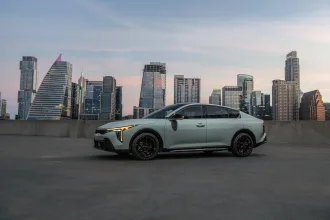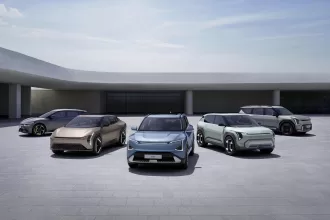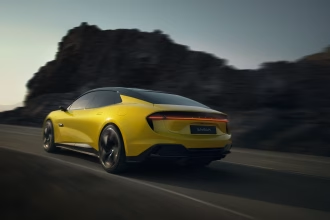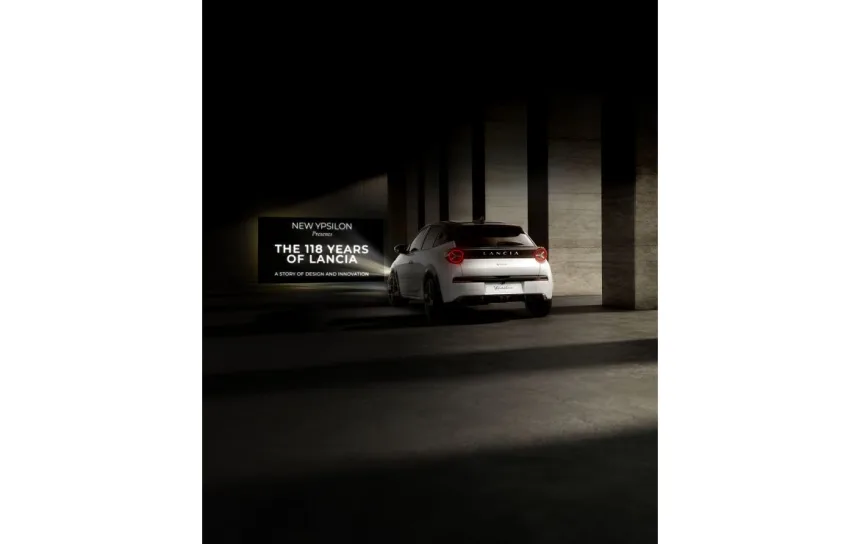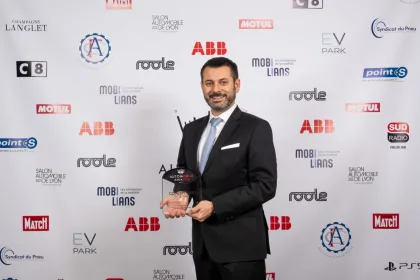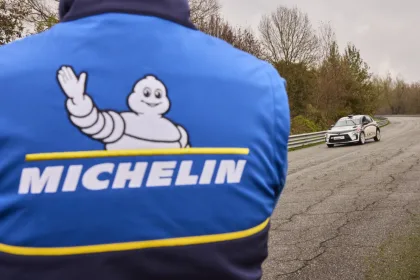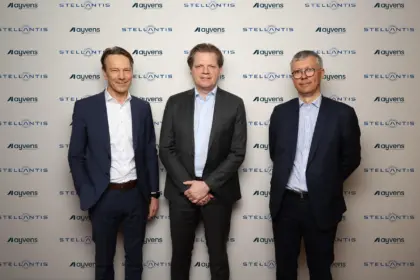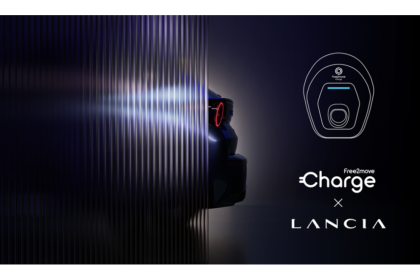In yet another major milestone, Lancia celebrates its 118th anniversary today, Wednesday, November 27th. To mark over a century’s worth of passion, style, and innovation, the brand has put together an enthralling video tribute which connects its past icons to its brand-new New Ypsilon, and has planned a series of events for employees at its production sites in Italy, France, and Spain.
Festivities will take place at the Lancia headquarters in Via Plava in Turin, where the company’s employees will get the chance to celebrate the occasion together with top management. Furthermore, they will also be able to admire a New Ypsilon in the lobby and speak with colleagues who worked on the project. In addition, the brand will host similar events at its factories in Zaragoza, Spain and Poissy, France to honor those who proudly and diligently contribute every day to writing a new chapter in Lancia’s history. Lastly, the new and exclusive Casa Lancia showrooms are yet another key ingredient in Lancia’s Renaissance: there are currently 160 locations in Italy, while 70 of them are planned to open across major cities in France, Spain, Belgium-Luxembourg, the Netherlands, and Germany by 2025.
Luca Napolitano, Lancia CEO, states: «I am proud to celebrate this anniversary and mark another milestone in a legendary story which tells of timeless elegance, technological innovation, and sporting records. Over its 118 years of history, Lancia has created beautiful, innovative, and uniquely Italian cars which, despite the passing of time, have always stayed dear to people».
The birth of a legend
The Lancia brand was founded in Turin on November 27, 1906 by Vincenzo Lancia and Claudio Fogolin, both Fiat employees and car enthusiasts. Vincenzo was already well-known in the automotive world, having achieved various sporting victories at the wheel of Fiat cars. The first car produced in 1908 was the Lancia 12 HP, a decidedly unconventional car for its time. Its chassis was low and lightweight, fitted with a drive shaft rather than chains, and it would become a genuine success story for its time with sales of over 100 units. Lancia’s fame grew and the brand got through World War I, after which other high-quality models would follow, including the Lambda, Augusta and Aprilia.
Following World War II, in 1950 Lancia unveiled the Aurelia, the first car in the world with a V6 engine. The model would go on to win various competitions, persuading Gianni Lancia – Vincenzo’s son – to found a racing department focused on competing on the road. It went on to be called the Scuderia Lancia. In 1956, the brand moved on to high-end cars: the icons of the 60s were the Flaminia and Flavia, the latter the first Italian car with its engine under the bonnet and front-wheel drive. In the early 1970s, the sports department was revived and went on to dominate the world of rallying for over 20 years, with the Stratos leading Lancia to the Mount Olympus of motorsport: fifteen World Rally Championships, three Constructors’ and Endurance World Championships, one 1000 Miglia, twice the Targa Florio, once the Carrera Panamericana. Beyond the sporting field, 1985 saw the debut of the compact Y10 at the Geneva Motor Show.
This model would go on to revolutionize the concept of a city car. The Ypsilon soon became a very successful line: over 37 special series, 4 generations, and the leader of its segment in Italy. Last April the baton was passed to the New Ypsilon, the forerunner of Lancia’s new era. Both its sinuous shapes and round taillights—a clear reference to the Lancia Stratos—are inspired by the brand’s historic models. Not to mention the fact that the New Lancia Ypsilon is the first Stellantis production car equipped with the S.A.L.A. system, the smart virtual interface that ensures a comfortable driving experience in line with Lancia’s effortless technology.
Moreover, the Italian brand’s latest creation is also best-in-class in the premium hatchback B-segment, courtesy of the most comprehensive specifications in its category: a large 10.25” display, the best standard parking aid system, the greatest exterior lighting system in terms of technology and extent; and it is also the only model in the segment equipped with Level 2 Autonomous Driving as standard on the Cassina version.
Timeless design
Lancia design has never been design for design’s sake, but rather the fullest expression of “Italian style”—i.e., that one-of-a-kind combination of classic elegance, creativity, and passion. Never a mere display of creative showmanship, this approach has given life to cars with a refined design which always aims to eliminate excess and find beauty in pure forms and content. Uncoincidentally, many Lancia cars have become part of the popular imagination: from the Aurelia to the Flaminia, the Fulvia, the Beta HPE, the Gamma, the Delta, the Stratos, and the 037. While some of these models sport a graceful and elegant design, others feature a brutal and efficient look. However, they all share a unique style which is capable of transcending space and time, keeping them beautiful, contemporary, and emblematic expressions of Italian design to this day.
Moreover, Lancia style has often “dressed” innovation in refinement. For instance, its wardrobe-like door opening patented in the 1930s, which featured no central pillar, was a forerunner to later innovations. In yet another example, the Aprilia was created based on the extraordinary idea of applying aerodynamics to a mass-produced compact car. For Lancia, it is all about craftsmanship and attention to detail: two characteristics which have set each of the brand’s models apart, both in the interiors and on the exteriors. Take, for instance, the iconic Aurelia B24 Spider, whose lines have been purified of anything superfluous: it features no handles and its doors open from the inside to keep its perfect line “undisturbed”.
Lancia also became an icon of Italian style with its Ferrari-powered Thema 8.32 which sported fine leather interiors and a solid-wood dashboard. Inspired by the fluidity of the historic Aurelia and Flaminia (and taking a touch of a sportiness from the legendary Stratos and Delta), the New Ypsilon is now the forerunner of a new design language which unites tradition to innovation. Moreover, the Centro Stile Lancia has experimented with contrasts, combining pure and sensual forms with bolder elements. The New Ypsilon’s distinctive details include a modern reinterpretation of the Lancia calice and Stratos-inspired rear lights. The interiors also exude Italian elegance with refined choices such as the tavolino and premium materials like recycled leather and ribbed velvet.
The evolution of an elegant, distinctive, and noble symbol
Lancia’s history is deeply intertwined with the evolution of its logo and the name of its models, both of which reflect the brand’s identity and values. The first logo unveiled in 1907 featured the “Lancia” lettering in white on a black background, with a prominent “L” and a minimalist look. In 1911, Vincenzo Lancia decided to entrust the creation of a new emblem to Count Carlo Biscaretti di Ruffia, who introduced elements like the four-spoke steering wheel, the rectangular flag, and the rod-shaped lance to best represent the brand’s philosophy. This design was officially adopted in 1922. In 1929, the logo underwent further transformations, adding a triangular shield around the steering wheel and a blue, white, and gold color combination which was destined to last.
In 1957, with the introduction of the Lancia Flaminia, the logo was once again redesigned, taking on a more modern and stylized look with simple geometric forms and a two-tone blue and silver look. Later, in 1969, following the acquisition of Lancia by the Fiat Group, the logo underwent another major restyling that saw the return of a rectangular shape, but brought the original 1907 design up to date. The 1972 Beta was the first car to show off the new emblem. In 1981, the designer Massimo Vignelli reinterpreted the logo, stylizing the traditional elements and limiting the color palette to an alteration of blue and white. In 2007, the logo became ever more minimalist by simplifying the design of the steering wheel and removing the lance with the flag, while maintaining the shield and the color. Even the names of the models reflect the brand’s history. Initially, the cars were identified by their registered horsepower, like 12 HP and 18/24 HP. However, in 1919, at the suggestion of his brother Giovanni, Vincenzo Lancia decided to use the letters of the Greek alphabet to give his cars a stronger identity, introducing the Kappa and continuing with models like the Lambda and Dilambda.
In the 1930s, the names changed and instead were inspired by historical locations in ancient Rome, like Aurelia, Appia, Flaminia, Flavia, and Fulvia. In the 1970s and 1980s, after Fiat purchased Lancia, the decision was made to return to tradition and go back to the use of Greek letters with models like the Beta, Gamma and Delta. In the early 2000s, this tradition was used on models like the Thesis, Phedra, the third generation of the Delta in 2008, up until the 2010 Ypsilon and the current New Ypsilon. The latter debuted a new logo which gives a modern interpretation to the distinctive elements of its historical counterpart—the steering wheel, the flag, the lance, and the lettering—as a way of looking towards the future. These foundational elements of the brand symbolize Lancia tradition and are now simplified in terms of lines and shapes in a new balance that expresses innovation, premiumness, and the Italian spirit, with a touch of eclecticism in full respect of the brand’s unmistakable geometries.
Lancia and Rallying
Lancia couldn’t properly celebrate its anniversary without paying tribute to its amazing success in the world of Rally, which has brought it to the Mount Olympus of motorsport with fifteen World Rally Championships, three Constructors’ and Endurance World Championships, one Mille Miglia, twice winning the Targa Florio and once the Carrera Panamericana. The 1970s and 1980s were the brand’s golden age, with legendary models like the Stratos, 037 and Delta dominating rallying for over 20 years. From early on, Lancia took note of this kind of competition, as its leaders knew they were perfect for highlighting the brilliance and road holding of its cars.
Moreover, the brand’s founder Vincenzo Lancia loved racing from early on. He had already won various races in the 1908-1909 season, but gave up competing to concentrate on the production of road cars. However, in 1951, Gianni Lancia decided to bring the brand back to racing and founded the Scuderia Lancia team, with its emblem a little elephant at a gallop. Between 1954 and 1955, the Lancia D50 single-seater partook in Formula 1, ending its sporting exploits. In the 1960s, Lancia made an official return to competing in rallies with the Lancia Racing Team, including a little red elephant as its emblem with the initials HF (‘High Fidelity’).
The Lancia Stratos HF, the first car designed specifically for rallying, made its official debut in 1974 and aimed to become unbeatable on any terrain. Equipped with the Ferrari Dino 2.4-litre V6, the Lancia Stratos HF was unrivalled and won three consecutive World Championships between 1974 and 1976. In 1983, the Rally 037 won the World Rally Championship in 1983—the last rear-wheel drive car to triumph at a World Championship—defeating advanced four-wheel drive vehicles like the much-feared Audi Quattro. Following the experience with powerful Group B cars, Lancia staked its claim with the four-wheel drive Delta HF 4WD, which debuted in 1987 and dominated the rallying scene for the next six years.
The Delta HF 4WD and its successors—the Delta HF Integrale and Integrale 16V—went on to win 10 world titles—6 in Constructors’ World Championships, 4 in its counterpart for Drivers—as well as of 46 wins out of the 66 world racing contests they took part in. The Lancia Delta remains the winningest car in rallying history, leaving an indelible mark on the world of motorsport. And today, the new Ypsilon Rally 4 HF is ready to hit the road in 2025, the year in which Lancia will make its comeback to motorsport. The brand’s aim is to reestablish its presence on the contemporary racing scene, while simultaneously paying homage to its glorious rallying past.
Lancia, Cinema and the Star System
Lancia represents excellence and is well-loved the world over by models, international A-listers, writers, and artists, as a symbol of the Italian culture of “beauty and a job well done”. Lancia cars have featured in films that have gone down in history, and in stylish, sophisticated communication campaigns. The relationship between Lancia and the movies dates back to the early days of the 20th century when Lancia cars appeared in the first silent films made in Turin. In particular, they would feature in the telefoni bianchi (‘white telephones’, 1930s Italian films in the style of the American comedies of the time), where these cars were chosen on the one hand as a vehicle for Italians’ dreams to cross the threshold of mille lire al mese (‘1000 Italian lire a month’, the average salary at that time); and on the other, almost as an embodiment of the key to the gates of the modern world.
In the late 1950s, the bond between the car brand and the ‘seventh art’ became unbreakable. This was the time of La dolce vita, with Rome the capital of cinema and the international jet set: Via Veneto pulsated with life and many stars chose Lancia for its unmistakable style. Claudia Cardinale, Anita Ekberg, and Jean Paul Belmondo drove models like the Aurelia and Appia, while Marcello Mastroianni opted for his Flaminia Coupé Super Sport Zagato. Enamored by the Aurelia B24, Flaminia, and Flavia Convertible, Brigitte Bardot could be seen driving Lancia cars from Cortina d’Ampezzo to the Côte d’Azur. Meanwhile, during his chronicles of the Spanish bullfighting season, Ernest Hemingway would travel with a Aurelia B21, his travel companion for his writings in “The Dangerous Summer”. In 1962, the Aurelia B24 featured in Dino Risi’s” Il sorpasso” and went on to become one of the most famous cars in Italian cinema history. Over the years, Lancia vehicles continued to star on the silver screen. The Fulvia Coupé appeared in Dario Argento’s “Profondo Rosso”, while Alain Delon is behind the wheel of the Lancia Delta in “Pour la peau d’un flic”. Recently, Lancia cars have been used in famous movies like Woody Allen’s “To Rome with Love” and Ron Howard’s “Angels & Demons”, with the Delta playing a starring role in the latter.
A symbol of Italian creativity and elegance, the Lancia brand also shines for its sophisticated advertising campaigns which respect the brand’s soul. The adverts made by the director Gabriele Muccino, accompanied by the music of Ennio Morricone, are much more than commercials, they are genuine short films which remain relevant to this day. Lancia’s choice of spokespeople—Stefano Gabbana, Richard Gere, and Carla Bruni—has fostered love for the brand. As ambassadors for Lancia elegance around the world, these celebrities have become “Very Ypsilon People” and contributed to making the brand an icon throughout the world. Lastly, we cannot go without mentioning its latest appearance on the big screen in “Race for Glory” starring Riccardo Scamarcio. A chronicle of one of the greatest competitions in sports history and an authentic battle between David and Goliath, the film tells the story of the 1983 Rally Championship in which the Lancia Team led by Cesario Fiorio and the 037 met a truly formidable opponent.

